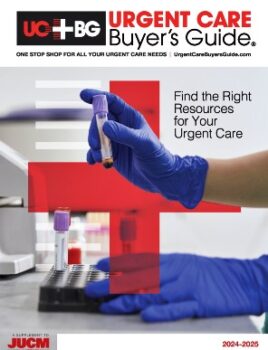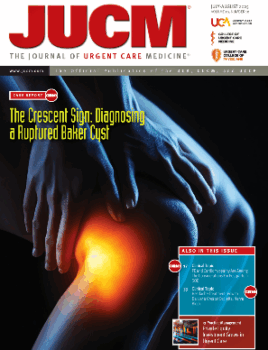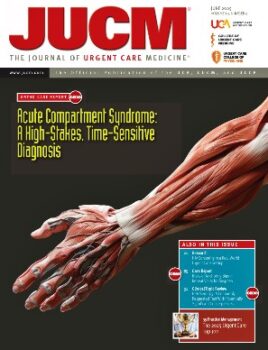![]()

Alan A. Ayers, MBA, MAcc is Chief Executive Officer of Velocity Urgent Care and is Practice Management Editor of The Journal of Urgent Care Medicine.
Urgent message: As the country’s urgent care markets become increasingly saturated, the forward-thinking operator will have a strategic patient-retention strategy ready when a competitor inevitably opens up shop in their community.
As the urgent care market continues its yearly growth of around 8%, per the Urgent Care Association’s 2018 Benchmarking Report, many markets around the country are seeing an oversaturation of urgent care centers. According to the St. Louis Business Journal, for instance, there are nearly 120 urgent care facilities in the 30 mile-radius of downtown St. Louis, a metropolitan area of 2.8 million people – with the researchers expecting that growth to continue. Similarly, the Washington, DC area has 131 urgent care centers; only seven are in the District of Columbia, leaving over 120 centers in a handful of Maryland and Virginia counties.
This is the reality of the urgent care landscape today: in many cities, competition for urgent care patients is being waged neighborhood by neighborhood, intersection by intersection, with new entrants popping up all the time.
Understanding the Competition
It’s important to note that “competitors” aren’t always urgent care centers whose capabilities align fully with yours. Retail clinics and pediatric-focused urgent care, for example, are expanding their footprints, disrupting markets, and offering patients additional on-demand care options. There is a great chance, therefore, that if you’ve yet to face a competing urgent care popping up in your market, it’s likely to happen soon. And given that there are a finite number of urgent care patients in any one community, you may wonder what made that competitor decide to put a stake down in your market.
There are a few common reasons, several of which may have indeed factored into your own decision-making when you choose to open your center:
- The competitor has done a thorough strengths, weaknesses, opportunities, and threats (SWOT) analysis in your market. If the SWOT analysis shows the competitor that the incumbent (you) is strongly positioned in the market with a loyal patient base, they’ll usually look elsewhere. However, if the competitor sees that the incumbent urgent care has weaknesses and vulnerabilities in its model, advertising, or service delivery, then they’ve likely decided that they can offer a better option and attract your patients to their center.
- Urgent care industry leaders maintain that despite the burgeoning number of on-demand care options, emergency rooms are still seeing and treating an abundance of nonemergency patients. They reason, therefore, that there is still room for more urgent care centers in some communities to educate and better serve those additional patients, with your competitors thinking likewise.
- A competitor that understands the urgent care demographic and their habits has spotted a specific opportunity in your market. For example, if they see an area (like a strip mall) with no urgent care nearby, but note there is a PetSmart, Target, or Kohl’s , then they know those retailers target the same demographic as urgent care (working women ages 25 to 55 with children). The competitor has leveraged the research other retailers have done on the demographic and figures they can out-position the incumbent if they build an urgent care center near those strong retail draws.
- Former providers or employees see the success of your practice, have learned your operating model and processes, think they have a loyal following of your patients who will follow them, and believe they can make more money opening a competing business than working for you.
What to Do If A Competitor Opens Nearby
There are a dwindling number of communities that have large-enough patient bases to support a bunch of urgent care centers in close proximity to one another. But for the most part, oversaturated markets dictate that any new entrants must siphon off your patient base and erode your market share. And since the urgent care space doesn’t have strong brand differentiation among the main players and operators, you can’t rely on brand loyalty to keep your patients and fend off competitors. Rather, defending your practice and protecting your market share will require you to implement and execute a multitiered strategy towards:
- Understanding what your competitor is offering
- Strengthening your weak points
- Capitalizing on your advantages
- Driving increased awareness of your center
- Showing patients your center is the best option
To that end, we’ll examine critical points of emphasis, why they matter, key factors to consider, and takeaways towards focusing your efforts and resources on fortifying your practice and strengthening your market position.
Point of Emphasis #1: Conduct Competitive Analysis
Why it matters: Your competitor has likely done a competitive analysis on you, so you must do the same. It’s the first step in understanding where you stand in relation to the competition, how they tend to out position you, and how their strengths and weaknesses stack up.
Key Factors to Consider
- The retail trade area – What’s the size of your retail trade area, wherein your urgent care draws the majority of its customers? Trade area is commonly evaluated by determining drive times and the population within a certain radius. For urgent care, depending on the population density, we consider a 12-15-minute drivetime. That could mean a 2-mile drive in an urban area with heavy traffic, or a 10-mile drive in a sparsely populated rural area. A competitor is a competitor if they inhabit the same retail trade area as your center.
- Which center has the best location – Who has the best major retail draws that create “flow-through” traffic? Retail draws include the aforementioned Kohl’s, Target, and PetSmart, as well as Lowes, and Walmart. Major grocery chains, Starbucks locations, banks, restaurants, and pharmacies are solid retail anchors, as well.
- The competitor’s operating model – What type of facility and operating hours? What is their scope of services and technology? Do they have lab and x-ray capabilities onsite? What’s their staffing model? What marketing tactics are they employing? What is their website and social media presence like? How do their offerings differ from yours? Lastly, how well do they execute these factors in comparison to your urgent care center?
- The first-person experience of utilizing the competitor’s center – Making a secret shopper-type visit to your competitor may be the most insightful method to gaining a complete view of the patient experience. You’ll see firsthand the interior of the facility, the clinical flow, and the registration processes. You’ll also experience the culture of the center, the competence of the providers, and the customer service orientation. Be mindful of signage, too; for example, does the competitor post a self—pay menu?. It’s important to use discretion while secret-shopping so the staff acts naturally and not defensive to an obvious spying competitor. Consider that the competitor may have done likewise and sent a “secret shopper” to your urgent care.
Takeaway: A thorough competitive analysis will be more detailed and in-depth than the above brief example. It remains a good starting point, however, to gain a grasp of how your competitor plans to operate in your market, and for your center to begin developing its defensive strategy.
Point of Emphasis #2 – Upgrade the Curb Appeal and Interior of Your Center
Why it matters: Experience and anecdote have taught us that patients aren’t typically knowledgeable enough to discern the clinical quality of their encounter, so they instead use the cleanliness and appearance of an urgent care center as a proxy for clinical expertise. Maintaining an attractive and pristine exterior, therefore, becomes a huge differentiator in the face of competition.
Key Factors to Consider
- The exterior – Well-lit, prominent signage. Maintained shrubbery, grass, walkways, and parking areas. Clean, pleasing aesthetics. Consider spending on upgraded signage along with an exterior makeover if necessary.
- No signs of center “fatigue” – All visible equipment should be functional. From a patient’s perspective, seeing equipment in a corridor with an “Out of Order” or “Do Not Use” label affixed to chairs or even vending machines creates a negative perception. We’ve seen negative, one-star Yelp reviews of urgent cares that caution about “broken and dirty” equipment.
- Cleanliness of all interior areas – Waiting area/lobby, corridors, restrooms, and exams rooms should be uncluttered and clean. Restrooms, in particular, should be checked often, as an unpleasant restroom experience is a major turnoff that could send your patient to your competitor.
- Awareness of patient needs – Even with a short wait, patients may be drawn to an urgent care center whose operators anticipate their needs before they can be seen. Free Wi-Fi and device-charging stations may seem unnecessary, but will be appreciated by patients who need them.
Takeaway: Appearance is critical to patient perceptions of an urgent care center, often beyond the clinical outcome. Developing and adhering faithfully to a facility checklist is key to keeping patients happy with your center and avoiding negative online reviews that could give your competitors an advantage.
Point of Emphasis #3 – Ensure that Your Center is Mom- and Kid-Friendly
Why it matters: Pediatric-focused urgent care centers are disrupting the market and, in the eyes of the coveted “soccer mom” demographic, are much “better” than conventional urgent cares for treating their kids. Your competitor could very well be a new pediatric urgent care, so you’ll need to ensure on-the-fence patients that your center is likewise mom- and kid- friendly.
Key Factors to Consider
- Pediatric urgent care is considered worth the extra effort – Focus group anecdote has shown that because of the perception that pediatric urgent care offers superior care option for kids, moms will make the extra drive beyond the local conventional urgent care to utilize them.
- A kid-friendly environment – A section of the lobby should be designated for kids. Games, tablets, stuffed animals, and toys help distract the child from their pain/illness, reduces their perceived wait time, and sets a positive tone for the visit.
- Borrow from pediatric urgent care and address the mother as “mom” throughout the visit; this deference and respect to the mother who drives the healing and recovering process has been shown to greatly appeal to “mom.”
- Let the child participate – Where age-appropriate, explain the procedure to the child, encourage them to ask questions, offer options when appropriate, and show them equipment and supplies. You don’t want to slow down throughput by overly explaining everything, but it will appeal to the mom to see that your staff is making an effort to ease their sick or injured child’s anxiety and take their mind off their discomfort.
Takeaway: The goal for your center is not to dominate the pediatric niche, but to retain patients who would otherwise spend the extra time and effort to drive to a further away pediatric urgent care. By clearly demonstrating that your service delivery caters to kids and moms, your center can remain competitive against new pediatric urgent care entrants.
Point of Emphasis #4 – Make Sure You’re Competing for Patients in Digital Channels
Why it matters: Consumer-driven companies are all leveraging technology to reduce the steps and effort involved in time-consuming tasks; in other words, they strive to reduce “friction” in using their products and services. Consumers expect the same in their healthcare providers; hence, leveraging technology to reduce the friction in utilizing your urgent gives you a competitive advantage.
Key Factors to Consider
- Perceived wait time – When evaluating your center against a competitor, a patient will definitely factor in wait time. By leveraging technology that allows them to reserve a spot online and receive text alerts when their time is approaching, the patient’s perceived wait time is drastically reduced since most of it is occurring away from the center.
- GPS apps – Especially in densely packed urban areas with heavy traffic, creating an account with a GPS app provider such as Waze allows patients to locate the center on their phone, better time their trips, and avoid traffic delays by discovering alternate routes. You could even pay for Waze ads to target nearby drivers to your urgent care.
- Online SEO – Google reports that the key phrase “urgent care near me” is surging in online searches. When someone has an urgent care need, they don’t go for the Yellow Pages anymore; they search on their phone. Ensuring that you allocate marketing dollars to your SEO so that your center shows in Google’s “local three-pack” gives you the competitive advantage of placing your urgent care “front and center” in online searches.
Takeaway: There are a ton of additional technology-based and digital-marketing tactics your center can employ to get in front of your patients where they spend much of their time—online. Research the popular ones, determine which tactics fit your marketing budget, and employ them as soon as possible since there’s a good chance your competitor is doing the same.
Point of Emphasis #5 – Increase Your Marketing Spend
Why it matters: Typically, a new urgent care center would have twice the budget to spend on marketing compared with an established center. Meaning, unless your center matches their marketing spend, the competing urgent care could be gaining a marketing advantage.
Key Factors to Consider
- Marketing channels the competitor is using – Where is the new urgent care focusing its marketing spend? Are their commercials on the radio? Are they advertising on the sides of buses? Do they have billboards around town? Can you tie up the desirable billboard locations? Is your current marketing in those channels strong or weak?
- Market strategically – It’s not about simply outspending the new urgent care competitor. Your center should be strategic in where and how you allocate your marketing dollars. Have your staff and patients noticed the competitor’s advertising? If so, where and which channel? Would it make more sense to spread your budget evenly among several channels, or focus on an important few?
Takeaway: Your urgent care competitor is spending thousands to achieve top-of-mind status and get your patients familiar with their offering as an alternative to you. Even if you’re top-of-mind currently, you’ll have to roll up your sleeves and examine your and their entire marketing initiative if you want to stay on top.
Point of Emphasis #6 – Ensure You’re In-Network with the Most Payers
Why it matters: A new competitor will be out-of-network with payers until they can complete the contracting and credentialing process to accept insurance.
Key Factors to Consider
- New patients of the competing center may be hit with out-of-network penalties or fees before the credentialing is completed, making them more likely to stay with your center because its credentialing is already established.
- Spend the time and effort to ensure that your center is in-network with as many additional payers as possible. Of course you’ll need to negotiate the best rates so your center is not losing money on a bad contract, but the fact that you take more insurance providers than your competitor will be a clear advantage.
Takeaway: Credentialing can be a confusing and time-consuming process, but the effort will be worth it in the end. Hire an expert to help you through the process if necessary, as that competitive advantage cannot be overstated.
Point of Emphasis #7 – Build a Strong Network of Cross-Referrals with Local PCPs
Why it matters: Although urgent care could be seen as a competitor to PCPs, building a mutually beneficial cross-referral relationship (called comanagement agreements by some operators) means the PCP will steer their patients toward you practice and not your competitor.
Key Factor to Consider
- Look for areas of collaboration and referrals. Introduce yourself to local PCPs and, for those that are receptive, point out how a relationship could be mutually beneficial. For example, you could agree to steer your patients to the PCP office for follow-ups, specialty visits, and consultations that your urgent care doesn’t handle, and the PCP could refer their patients to your urgent care for low-acuity issues when their office is closed or there is a lengthy appointment wait.
Takeaway: Not every PCP will be receptive to your center’s offer, with some actively steering their patients away from your practice. The ones who do recognize the mutually beneficial relationship, however, can provide you with a source of patient referrals that your competitor doesn’t have.
Point of Emphasis #8 – Closely Manage Your Online Reputation
Why it matters: In online searches, your competitor’s urgent care center is likely placed right next to yours. The center with the most positive (and the fewest negative) reviews might be the deciding factor to which option a patient chooses.
Key Factors to Consider:
- Ensure that your urgent care is registered with Google My Business then, strive to get your center into the Google “local three-pack” (when a patient types in a keyword like “urgent care near me” into Google, the top three results shows first). If your center is among the first three results, its average star rating and the number of reviews it has is prominently displayed. When the searcher clicks your urgent care listing, another page opens to reveal more detailed information such as address, hours, phone, questions and answers, and a summary of your reviews and star rating average.
- The aforementioned UCA Benchmarking Report indicates that 96% of urgent care centers use social media in its advertising. The most popular social media channel for urgent care is Facebook Business Pages, which includes a section for reviews and star ratings as well.
- The competing urgent care will have their families and friends provide them 5-star reviews and will have reviews promoting their short wait times since they are a start-up with a small patient base.
- Maintaining the all-important positive reviews requires a proactive approach. Your center’s staff must be diligent in asking patients for feedback about their service or concerns before they leave your urgent care, or shortly thereafter with a survey. Any negative comments or concerns should be followed up immediately before the patient goes online to post a bad review. Also keep in mind that 95% of people will return to a business if their issue is quickly resolved.
Takeaway: There are numerous examples online of upset patients pulling out their phone and going online to post a negative review—as they sit in the lobby of your urgent care. It’s much easier to prevent a negative rating than to try to get one removed later, provided there is a strong emphasis on continually checking with patients to make sure they are happy with your service delivery. The negative reviewers will not come back to your center, but they will try out the new urgent care that just opened down the road.
Point of Emphasis #9 – Strengthen Your Community Relationships
Why it matters: In addition to being medical care providers, urgent care operators are also retailers who must aggressively market to draw in the necessary new business to stay ahead of competitors. This often means getting involved in the local community to provide patient education about urgent care, support other businesses and organizations, and to drive awareness to their center.
Key Factors to Consider
- See if you can get “exclusives” on certain community sponsorships – Work out arrangements with receptive community organizations that will allow your urgent care to be their “exclusive” sponsor.
- Expand your pre-existing community relationships. Depending on your marketing budget, there are a number of community organizations that your urgent care can get involved with:
- Churches/religious congregations
- Athletic boosters
- Chamber of commerce
- Local parks and recreation
- Volunteer/service organizations
- Local 5k runs
- Advocacy organizations
- Community even organizers
Takeaway: Having a stronger community presence than your local competitors is an advantage that can reap huge dividends insofar as creating loyalty and top-of-mind awareness. When there is a choice to be made, the local residents will choose the urgent care they have an affiliation with.
Point of Emphasis #10 – Focus on Improving Your Net Promoter Score (NPS)
Why it matters: The NPS score is one of the most reliable measures of patient satisfaction (or dissatisfaction) with your urgent care. Striving to ensure that your NPS is as high as possible will help keep your patients from having a dissatisfying experience that could steer them to your competitors.
Key Factors to Consider
- Long wait times are the #1 detractor to patient satisfaction and result in lower NPS scores; Implement measures at every opportunity to shorten wait times in your center (as long as they don’t sacrifice clinical quality). In addition to the aforementioned “save your spot in line” and text alerts that offload the wait from the lobby to their home, consider implementing standing orders to expedite patient care through the clinical workflow. Take care to implement standing orders judiciously, though, to avoid any chance of liability.
- Place a renewed emphasis on culture – Studies show that the vast majority of online complaints and negative reviews are customer-service related. A compassionate, caring, customer-facing staff has an outsized impact on the perceptions of your center, and warm, positive interactions can boost your NPS scores.
- Make the interaction feel personal to increase NPS scores – Train your staff to introduce themselves during every patient encounter and use the patient’s name whenever possible. This practice not only shows respect for the patient, but it increases the likelihood that they will express their concerns on the spot, rather than going to social media to post a negative review.
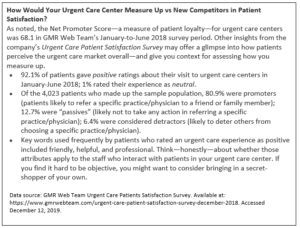
Takeaway: Healthcare marketing agency GMR Web Team has stated that the average NPS score for urgent care is 68.1 (out of a 4,736-clinic sample). If your center works diligently to boost your NPS beyond that number into at least the 80s, you stand well-positioned to maintain and ever grow your patient base.
Point of Emphasis #11 – Don’t Bad Mouth Your Competitor
Why it matters: There have been recent legal cases where rival urgent care providers became embroiled in lawsuits over a perceived defamation of one center of another. This underscores the importance of being careful when making a statement about another urgent care center.
Key Factors to Consider
- Think twice before making a disparaging or inaccurate claim about a competitor online. This behavior can result in unneeded liability and expensive litigation. It’s best to play it safe and err on the side of caution.
- Consider what it says about your practice if you’re disparaging the competition – Is your center unable to stand on its own reputation of high-quality service, having to resort to attempts to tarnish another businesses reputation? Taking the high road always casts your center in the most favorable light and demonstrates that your business operates with the kind of integrity that engenders loyalty and patient retention.
Takeaway: Always double-check the facts before saying anything that can be perceived as a negative by a competitor. And even when something is factually correct, carefully weigh the benefits and drawbacks before repeating it.
Point of Emphasis #12 – Consider A Grand Reopening
Why it matters: Just because a competing urgent care center is opening nearby doesn’t mean they’re entitled to all the local buzz. A strategic grand reopening can steal some of their buzz and draw attention to your center.
Key Factors to Consider
- Capitalize on any significant development – Has your urgent care brought in new providers? Updated the lobby or exterior? Hit a company milestone? Added new service offerings? Any significant change, development, or upgrade could be an occasion for a grand reopening.
- The grand reopening gets people talking about your urgent care and can attract new patients. Advertising the grand opening can help neutralize the “newness” and novelty of the competitor and keep your center top-of-mind.
- Get the word out – Use social media, create an advertisement online, or have a press release created to let the entire community know about your exciting re-launch. You can also add temporary signage like sail flags and building banners, or a hire a sign flipper (all subject to municipal codes) to increase your site’s visibility amid the re-launch.
Takeaway: A grand reopening shows the community that your center is continually improving and innovating your service model to provide the best patient care in your city. Your center doesn’t have to sit idly by and watch the new competitor grab all the headlines.
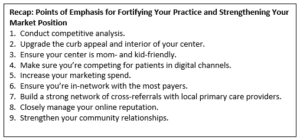
Conclusion
Amid increasing competition from rival urgent care centers and other disruptive entrants, urgent care operators must mobilize on all fronts to retain their patients and stave off aggressive competitors. Urgent care markets, like most others, tend to self-regulate—meaning that the smartest operators who can provide the best service at the lowest costs are the ones who will remain profitable. In the end, it will come down to the urgent care operator who fine-tunes their entire business model the best, keeps their finger on the pulse of the industry, and provides their patients with highest-quality experience.
 480-245-6400
480-245-6400







